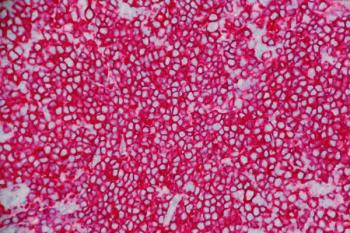
5-FU Toxicity and DPD: A New Option to Treat Pyrimidine Analogue Overdose
5-Fluorouracil is the mainstay of treatment for many cancers, with upwards of 30% rates of adverse effects. DPD deficiency can further amplify these effects and even lead to life-threatening toxicity. Uridine triacetate is FDA approved for 5-FU and capecitabine overdose treatment within 96 hours of administration.
5-Fluorouracil is the mainstay of treatment for many
What is DPD deficiency? It is a lack of the enzyme dihydropyrimidine dehydrogenase, caused by mutation in the DPYD gene, specifically within human chromosomal region 1p22.1,2 The DPYD*2A variant is present in 40% to 50% of people with partial or complete DPD deficiency, which is estimated to affect 3% to 5% of the general population, alongside ethnic subpopulation variability.1
The DPD enzyme is responsible for metabolizing the pyrimidines uracil and thymine.2 The significance of this in clinical practice lies within the administration of pyrimidine analogues (eg, 5-fluorouracil [5-FU] and capecitabine) for anti-tumor activity.
The Basics
5-FU is a halogenated pyrimidine. As it is also a pro-drug, it requires conversion to its 3 active metabolites: fluorodeoxyuridine monophosphate (FdUMP); fluorodeoxyuridine triphosphate (FdUTP); and fluorouridine triphosphate (FUTP).
These metabolites serve to incorporate into the RNA and DNA and to inhibit thymidylate synthase, blocking thymidine synthesis and thereby allowing the drug to exert its cytotoxic effects. Under normal conditions, however, more than 80% of the drug is metabolized in the liver, where the rate-limiting enzyme DPD converts it to inactive dihydrofluorouracil (DHFU).3 Capecitabine, another anti-tumor agent, is a pro-drug that is converted to 5-FU in the body.
5-FU Toxicity
Although differences in the administration route of 5-FU can yield different rates of adverse effects, these can be upwards of 30%. They include thrombocytopenia, neutropenia, mucositis, diarrhea, and hand-foot syndrome.1,4 In DPD deficiencies, these toxicities are magnified and present alongside neurologic manifestations, cardiac problems, and death. This is due to an increase in active metabolites and decreased elimination of the drug. In fact, more than 40% of patients who have exhibited grade 3 or above toxicity to 5-FU had some degree of DPD deficiency.4,5
Latest Treatment
Before the existence of an “antidote,” supportive care alone was the standard treatment.6 Uridine triacetate (Vistogard) earned FDA approval in 2015, indicated for fluorouracil or capecitabine overdose in an emergent setting, regardless of the presence of symptoms or for patients displaying symptoms within 96 hours of administration. This pro-drug is first converted to uridine by esterases, and the “excess circulating” uridine is eventually converted to uridine triphosphate (UTP), competitively inhibiting FUTP for incorporation into RNA.7
Administration
The recommended dosage for adults is 10 grams orally every 6 hours for 20 doses. Pediatric dosing is by body surface area, at 6.2 grams/m2 orally every 6 hours for 20 doses. Administration can be via nasogastric or gastrostomy tube with the drug dissolved in a food starch-based thickening product. 7
References
1. Yen JL, McLeod LH. Should DPD analysis be required prior to prescribing fluoropyrimidines? Eur J Cancer. 2007;43(6): 1011-6.
2. Dihydropyrimidine dehydrogenase deficiency. Genetics Home Reference. U.S. National Library of Medicine. https://ghr.nlm.nih.gov/condition/dihydropyrimidine-dehydrogenase-deficiency#genes. Published September 19, 2017. Accessed September 21, 2017.
3. Longley DB, Harkin DP, Johnston PG. 5-Fluorouracil: mechanisms of action and clinical strategies. Nature Rev Cancer. 2003;3(5):330-8.
4. Meta-Analysis Group in Cancer, Lévy E, Piedbois P, Buyse M, Pignon JP, Rougier P, et al. Toxicity of fluorouracil in patients with advanced colorectal cancer: effect of administration schedule and prognostic factors. J Clinical Oncol. 1998;16(11):3537-41.
5. Law L, Rogers J, Eng C. Delayed presentation of DPD deficiency in colorectal cancer. J Adv Pract Oncol. 2014;5(3):205—10.
6. Ma WW, Saif MW, El-Rayes BF, Fakih MG, Cartwright TH, Posey, JA, et al. Emergency use of uridine triacetate for the prevention and treatment of life threatening 5 fluorouracil and capecitabine toxicity. Cancer. 2017;123(2): 345-356. doi: 10.1002/cncr.30321.
7. Vistogard [prescribing information]. Gaithersburg, MD: Wellstat Therapeutics, Corporation; 2015. https://www.vistogard.com/Vistogard/media/Main-Media/final-labeling-text-vistogard.pdf. Accessed September 20, 2017.
Newsletter
Stay informed on drug updates, treatment guidelines, and pharmacy practice trends—subscribe to Pharmacy Times for weekly clinical insights.














































































































































































































